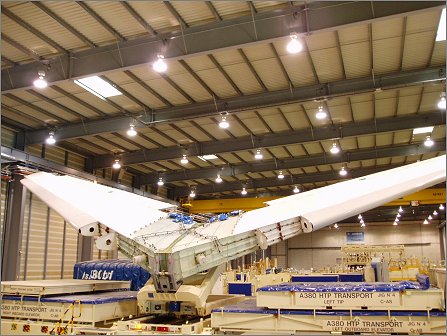In 2000, as CASA became part of EADS, the old organisation was split into two with the Airbus facilities becoming 100%-owned by Airbus under the Airbus España banner. The remainder, comprising the military and overhaul businesses, became EADS Casa, which is the larger of the two old CASA divisions.
|
A380 HTP's are assembled in Puerto Real |
Airbus España’s “more than 3,000 employees” represent around 5% of Airbus’s total headcount, and work at three plants – Getafe near Madrid, Illescas (located near Toledo and around 30km [18 miles] from Getafe) and Puerto Real on the south coast near the port of Cadiz. The Airbus España and EADS Casa businesses operate side-by-side at several of the plants.
The Airbus division’s main activities are engineering (both design and processes); development, manufacturing and assembly of composite structures (it is an Airbus centre of excellence in advanced composites); and design and manufacturing of tooling. The division produces 4.2% of all production Airbus aircraft except the A380, where its share is 10%. The A350 workshare is not yet finalised, but is expected to be “slightly less” than the A380.
The division’s main responsibility is the production and assembly of horizontal stabilisers – called horizontal tail planes (HTP) by Airbus – for all Airbus aircraft. Other non-A380 work packages include forward passenger doors (A300/A310 and A330/A340), landing gear doors (A300/A310 and A320) and fuselage Section 18 for the A320.
On the A380, the expanded workshare sees it build the HTP, the entire rear fuselage (Section 19 and 19.1), rudder, dorsal fin fairing, belly fairing, main landing gear doors (wing and body) and some composite wing ribs.
Two thirds of the staff work at Getafe, which is the division’s headquarters and undertakes final assembly of HTPs for all the Airbus models (except the A380), and also assembles the A380’s Section 19/19/1 rear fuselage. Getafe’s EADS Casa facilities includes the Spanish Eurofighter Typhoon assembly line and military overhaul businesses.
While the A380’s rear fuselage can be squeezed into an Airbus Beluga for transport from Getafe to Hamburg, the size of the A380’s HTP necessitates surface shipment. For this reason the HTPs are assembled at Puerto Real and can be transferred via Cadiz by ship/barge and truck to the Toulouse final assembly line.
For all aircraft other than the A380, HTP lateral boxes assembled by the Puerto Real plant and trucked to the HTP assembly line in Getafe. The process is reversed for the A380, with Getafe producing the lateral boxes which are then trucked to Puerto Real for final assembly. Puerto Real also assembles the rudder and belly fairing that are transferred by ship.
Much of the material used on the Getafe and Puerto Real assembly lines originates from the Illescas plant. This is Airbus España’s advanced composites centre, claiming to account for 10% of the worldwide consumption of composites and a supplier to other part of the old CASA. “A key decision taken when EADS was created was that for Spain one division must give support to another,” says Airbus España general manager Manuel Hita. “So parts are produced for the other divisions, for example the carbonfibre skin for the Eurofighter’s right wing is produced in Illescas.”
Over the last five years, the Airbus division has expanded by 50%, with growth being driven partly because of its increased workshare on the A380 and partly due to output increases on the existing programmes. “We’ve grown in parallel with the growth of Airbus,” says Hita. He acknowledges that the country’s relatively lower wage rates makes the division a lower cost business than other parts of Airbus, “but not too much”.
In 2004, there was some controversy ahead of the Spanish general elections when the government threatened to withhold part of its development funding for the A380, as it believed that the country’s industry had not secured sufficient workshare. The then science and technology minister said that, while the objective was to have a 10% share, “currently we have less than 8%”.
Airbus España is reluctant to discuss if and how this issue was resolved, Although Hita says “the support of the Spain’s governments – federal, regional and local – has been a great benefit to Airbus”. He adds that because the company’s policy has always been to outsource locally “the Spanish aerospace network has grown simultaneously with us. We employ 3,000 people and a similar magnitude of people is employed by Spanish suppliers on Airbus work outside this division. Practically all the manual processes are subcontracted to the first and second tier suppliers.”
Hita also says that the Airbus programmes enables Spain’s aerospace suppliers expand on a global scale, particularly those working in the composites area.
Source: Flight International




















